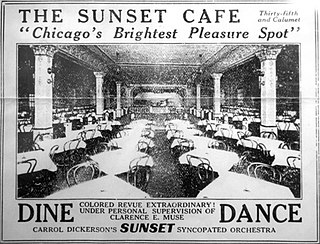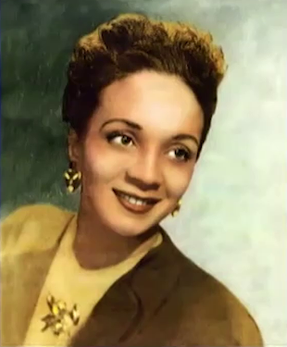Related Research Articles

Bebop or bop is a style of jazz developed in the early to mid-1940s in the United States. The style features compositions characterized by a fast tempo, complex chord progressions with rapid chord changes and numerous changes of key, instrumental virtuosity, and improvisation based on a combination of harmonic structure, the use of scales and occasional references to the melody.

John Birks "Dizzy" Gillespie was an American jazz trumpeter, bandleader, composer, educator and singer. He was a trumpet virtuoso and improviser, building on the virtuosic style of Roy Eldridge but adding layers of harmonic and rhythmic complexity previously unheard in jazz. His combination of musicianship, showmanship, and wit made him a leading popularizer of the new music called bebop. His beret and horn-rimmed spectacles, scat singing, bent horn, pouched cheeks, and light-hearted personality have made him an enduring icon.

William James "Count" Basie was an American jazz pianist, organist, bandleader, and composer. In 1935, he formed the Count Basie Orchestra, and in 1936 took them to Chicago for a long engagement and their first recording. He led the group for almost 50 years, creating innovations like the use of two "split" tenor saxophones, emphasizing the rhythm section, riffing with a big band, using arrangers to broaden their sound, his minimalist piano style, and others.

William Clarence Eckstine was an American jazz and pop singer and a bandleader during the swing and bebop eras. He was noted for his rich, almost operatic bass-baritone voice. In 2019, Eckstine was posthumously awarded the Grammy Lifetime Achievement Award "for performers who, during their lifetimes, have made creative contributions of outstanding artistic significance to the field of recording". His recording of "I Apologize" was given the Grammy Hall of Fame Award in 1999. The New York Times described him as an "influential band leader" whose "suave bass-baritone" and "full-throated, sugary approach to popular songs inspired singers like Earl Coleman, Johnny Hartman, Joe Williams, Arthur Prysock, and Lou Rawls."

Theodore "Fats" Navarro was an American jazz trumpet player and a pioneer of the bebop style of jazz improvisation in the 1940s. A native of Key West, Florida, he toured with big bands before achieving fame as a bebop trumpeter in New York. Following a series of studio sessions with leading bebop figures including Tadd Dameron, Bud Powell, and Kenny Clarke, he became ill with tuberculosis and died at the age of 26. Despite the short duration of his career, he had a strong stylistic influence on trumpet players who rose to fame in later decades, including Clifford Brown and Lee Morgan.

Albert J. "Budd" Johnson III was an American jazz saxophonist and clarinetist who worked extensively with, among others, Ben Webster, Benny Goodman, Big Joe Turner, Coleman Hawkins, Dizzy Gillespie, Duke Ellington, Quincy Jones, Count Basie, Billie Holiday and, especially, Earl Hines.

Clora Larea Bryant was an American jazz trumpeter. She was the only female trumpeter to perform with Dizzy Gillespie and Charlie Parker and was a member of the International Sweethearts of Rhythm.

Velma Middleton was an American jazz vocalist and entertainer who sang with Louis Armstrong's big bands and small groups from 1942 until her death.

The Sunset Cafe, also known as The Grand Terrace Cafe or simply Grand Terrace, was a jazz club in Chicago, Illinois operating during the 1920s, 1930s and 1940s. It was one of the most important jazz clubs in America, especially during the period between 1917 and 1928 when Chicago became a creative capital of jazz innovation and again during the emergence of bebop in the early 1940s. From its inception, the club was a rarity as a haven from segregation, since the Sunset Cafe was an integrated or "Black and Tan" club where African Americans, along with other ethnicities, could mingle freely with white Americans without much fear of reprisal. Many important musicians developed their careers at the Sunset/Grand Terrace Cafe.
Leslie Spann Jr. was an American jazz guitarist and flautist. As a sideman he recorded with Nat Adderley, Benny Bailey, Bill Coleman, Eddie "Lockjaw" Davis, Curtis Fuller, Red Garland, Benny Goodman, Sam Jones, Abbey Lincoln, Charles Mingus, Duke Pearson, Jerome Richardson, Charlie Shavers, Sonny Stitt, Billy Taylor, Randy Weston, and Ben Webster. As a leader he recorded only once, the album Gemini in 1961.

Jivin' in Be-Bop is a 1947 musical film produced by William D. Alexander and starring Dizzy Gillespie and His Orchestra, which included notable musicians such as bassist Ray Brown, vibraphonist Milt Jackson, and pianist John Lewis. It also features singers Helen Humes and Kenny "Pancho" Hagood, Master of Ceremonies Freddie Carter, and a group of dancers.

William D. Alexander was an American filmmaker. He made U.S. government-sponsored newsreels for African American audiences. He later established his own production company, Alexander Productions, in New York City and became a film producer.

Dizzy Gillespie at Newport is a 1957 live album by Dizzy Gillespie, featuring his big band, recorded at the 1957 Newport Jazz Festival.

"Manteca" is one of the earliest foundational tunes of Afro-Cuban jazz. Co-written by Dizzy Gillespie, Chano Pozo and Gil Fuller in 1947, it is among the most famous of Gillespie's recordings and is "one of the most important records ever made in the United States", according to Gary Giddins of The Village Voice. "Manteca" is the first tune rhythmically based on the clave to become a jazz standard.

Dizzy in Greece is an album by trumpeter Dizzy Gillespie, recorded in 1956 and 1957 and released on the Verve label. The album was reissued as part of the 2CD compilation Birks Works: The Verve Big Band Sessions.
James Theodore Powell was an American jazz saxophonist who played alto sax.

Ann Baker was an American jazz singer. Baker was discovered by Louie Armstrong and played with his band on Broadway. She is best known for her time spent as a member of Billy Eckstine's band, "The Dream Band" where she performed with Charlie Parker, Dizzy Gillespie, Dexter Gordon, Miles Davis and Art Blakey.
Arnold Ross was an American jazz pianist.
Harlem Hotshots is an American short film from 1940 produced by Sack Amusements. The 20 minute film is a musical. One poster for the film includes a skyline of buildings and street sign for Lenox Avenue and 125th Street. The film was reissued in 1986 as part of Jazz Classics, No. 110; Harlem Harmonies Volume 1, 1940–1945.
Hortense Allen Jordan was an African-American dancer, choreographer, costume designer, and producer.
References
- 1 2 Webb, Graham (July 13, 2020). Encyclopedia of American Short Films, 1926–1959. McFarland. ISBN 978-1-4766-8118-4 – via Google Books.
- ↑ "Celluloid Improvisations ♫ LEARN". www.jazz-on-film.com.
- ↑ Pitts, Michael R. (2019-04-25). Astor Pictures: A Filmography and History of the Reissue King, 1933–1965. McFarland. p. 136. ISBN 978-1-4766-7649-4 – via Google Books.
- ↑ Stratemann, Klaus (November 29, 1981). Negro Bands on Film: Big bands, 1928–1950. Verlag Uhle & Kleimann. ISBN 978-3-922657-18-7 – via Google Books.
- ↑ Moon, Spencer; Allen, Linda (November 29, 1997). Reel Black Talk: A Sourcebook of 50 American Filmmakers. Greenwood Publishing Group. ISBN 978-0-313-29830-1 – via Google Books.
- ↑ "RHYTHM IN A RIFF". Library of Congress.
- ↑ "Eckstine, Millinder Make Pix to Hypo Tour Grosses". Billboard. July 27, 1946 – via Google Books.
- ↑ Jackson, Kenneth T.; Markoe, Karen; Markoe, Arnie; Markoe, Arnold (November 29, 2001). The Scribner Encyclopedia of American Lives: 1991–1993. Vol. 3. Charles Scribner's Sons. ISBN 978-0-684-80492-7 – via Google Books.
- ↑ Rustin, Nichole T.; Tucker, Sherrie (November 7, 2008). Big Ears: Listening for Gender in Jazz Studies. Duke University Press. ISBN 978-0-8223-4320-2 – via Google Books.
- ↑ Clear, Rebecca D. (November 29, 1993). Jazz on Film and Video in the Library of Congress. DIANE Publishing. ISBN 978-0-7881-1436-6 – via Google Books.
- ↑ "Indianapolis Recorder 3 September 1949 — Hoosier State Chronicles: Indiana's Digital Historic Newspaper Program" – via newspapers.library.in.gov.
- ↑ Sims, Gayle Ronan (23 March 2008). "Ex-dancer Hortense Allen Jordan dies at 88". Inquirer.
- ↑ "Permanent Collection". Oakton Community College.
- ↑ "King Kolax Discography". campber.people.clemson.edu.